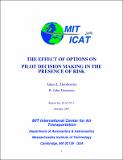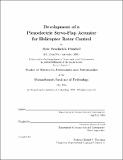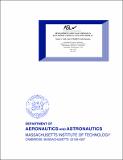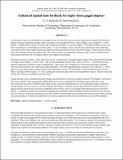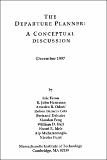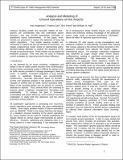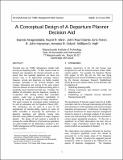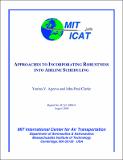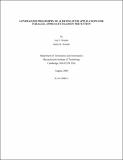Browsing ICAT - Reports and Papers by Issue Date
Now showing items 1-20 of 192
-
The Effect Of Options On Pilot Decision Making In The Presence Of Risk
(International Center for Air Transportation, 97-10)An Option-Based Decision Framework is developed. This Framework may be applied to decisions that must be made in the face of high risk. The work is motivated by the needs of decision makers, specifically aviation decision ... -
Development of a Piezoelectric Servo-Flap Actuator for Helicopter Rotor Control
(International Center for Air Transportation, 1994-04-24)An actuator using a piezoelectric bender to de ect a trailing edge servo- ap for use on a helicopter rotor blade was designed, built, and tested. This actuator is an improvement over one developed previously at MIT. ... -
A Human Subject Evaluation of Airport Surface Situational Awareness Using Prototypical Flight Deck Electronic Taxi Chart Displays
(1994-08)The advent of Instrument Landing Systems has allowed aircraft to safely takeoff and land in low visibility conditions. However, the lack of a means by which pilots can safely navigate on the ground in poor visibility ... -
Experimental Study of Vertical Flight Path Mode Awareness
(International Center for Air Transportation, 1995-03)An experimental simulator study was run to test pilot detection of an error in autopilot mode selection. Active airline air crew were asked to fly landing approaches by commanding the Flight Path Angle mode while monitoring ... -
An Exploratory Survey of Informantion Requirements for Instrument Approach Charts
(National Technical Information Service, 1995-03) -
Development and Evaluation of an Electronic Vertical Situation Display
(International Center for Air Transportation, 1996-06)Current advanced commercial transport aircraft, such as the Boeing B777/B747-400, the Airbus A320/A340 and the McDonnell Douglas MD-11, rely on AutoFlight Systems (AFS) for flight management, navigation and inner loop ... -
Enhanced spatial state feedback for night vision goggle displays
(1997-04)A preliminary study was conducted to investigate the use of visual flow cues as an aid to ground and vertical drift awareness during helicopter flight and targeting while using night vision goggles (NVG's). Three displays ... -
Experimental Studies of the Effect of Intent Information on
(Internationa, 1997-05)Intent information provides knowledge of another aircraft’s current and future trajectory states. Prototype traffic displays were designed for four different levels of intent: Position, Rate, Commanded State, and FMS-Path. ... -
The Departure Planner: A Conceptual Discussion
(1997-12) -
Situation Awareness Information Requirements For Commercial Airline Pilots
(International Center for Air Transportation, 1998-09)Situation awareness is presented as a fundamental requirement for good airmanship, forming the basis for pilot decision making and performance. To develop a better understanding of the role of situation awareness in flying, ... -
An Experimental Study of the Effect of Shared Information on Pilot/Controller Re-Route Negotiation
(International Center for Air Transportation, 1999-01)Air–ground data link systems are being developed to enable pilots and air traffic controllers to share information more fully. The sharing of information is generally expected to enhance their shared situation awareness ... -
Resolution of Conflicts Involving Many Aircraft via Semidefinite Programming
(1999-04)Aircraft conflict detection and resolution is currently attracting the interest of many air transportation service providers and is concerned with the following question: Given a set of airborne aircraft and their intended ... -
The Impact of GPS Velocity Based Flight Control on Flight Instrumentation Architecture
(International Center for Air Transportation, 1999-06)This thesis explores the use of velocity information obtained by a Global Positioning System (GPS) receiver to close the aircraft’s flight control loop. A novel framework to synthesize attitude information from GPS ... -
Semi-Structured Decision Processes: A Conceptual Framework for Understanding Human-Automation Decision Systems
(International Center for Air Transportation, 1999-09)The purpose of this work is to improve understanding of existing and proposed decision systems, ideally to improve the design of future systems. A "decision system" is defined as a collection of information-processing ... -
Cockpit Weather Information System Requirements for Flight Operations in Icing Conditions
(International Center for Air Transportation, 2000-02)In order to support the development of remote sensing technologies, the requirements of cockpit information systems for flight operations in icing conditions were investigated. Pilot information needs were investigated ... -
Analysis of Complexity Evolution Management and Human Performance Issues in Commercial Aircraft Automation Systems
(2000-05)Autoflight systems in the current generation of aircraft have been implicated in several recent incidents and accidents. A contributory aspect to these incidents may be the manner in which aircraft transition between ... -
Analysis and Modeling of Ground Operations at Hub Airports
(2000-06)Building simple and accurate models of hub airports can considerably help one understand airport dynamics, and may provide quantitative estimates of operational airport improvements. In this paper, three models are proposed ... -
A Conceptual Design of A Departure Planner Decision Aid
(2000-06)Terminal area Air Traffic Management handles both arriving and departing traffic. To date, research work on terminal area operations has focused primarily on the arrival flow and typically departures are taken into account ... -
Approaches to Incorporating Robustness into Airline Scheduling
(2000-08)The airline scheduling process used by major airlines today aims to develop opti- mal schedules which maximize revenue. However, these schedules are often far from \optimal" once deployed in the real world because they ... -
Generalized Philosophy of Alerting with Applications for Parallel Approach Collision Prevention
(2000-08)An alerting system is automation designed to reduce the likelihood of undesirable outcomes that are due to rare failures in a human-controlled system. It accomplishes this by monitoring the system, and issuing warning ...
